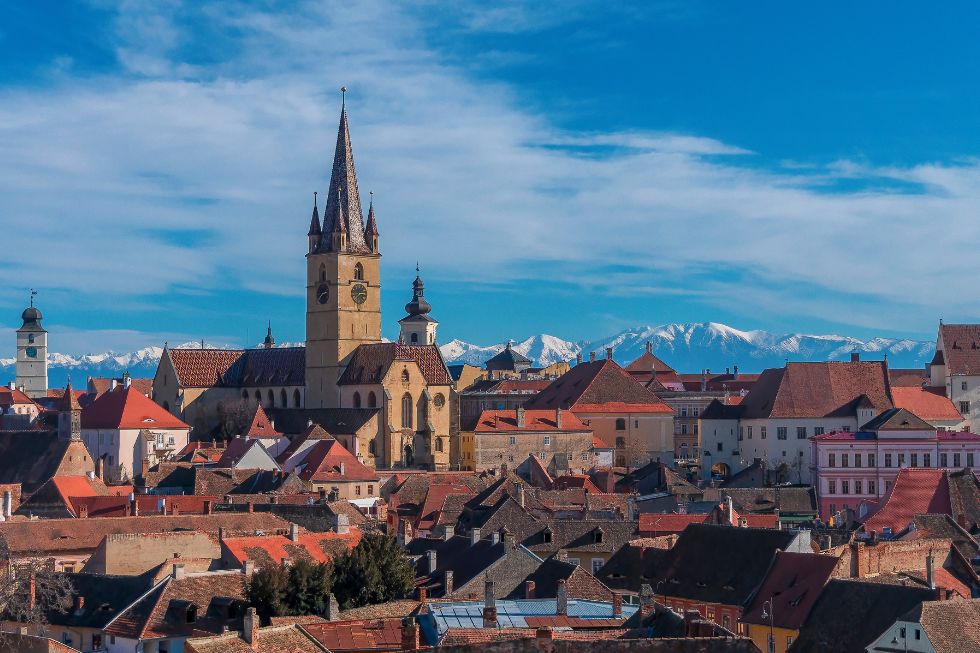“For a kingdom with only one language and one custom is weak and fragile.” This sentence, written around 1030 by King Stephen I of Hungary, can be regarded as a cornerstone in the argument for preserving the diverse population in Southeastern Europe and Romania. It is not widely known that German settlement groups were also part of this population diversity for many centuries. Around 1930, approximately 700,000 Germans lived in the area of present-day Romania in various groups that were historically, culturally and regionally distinct from one another. The two largest groups were the Transylvanian Saxons in central Romania, and the Banat Swabians who settled in western Romania.
Starting in the 1970s, a remigration movement of Germans led to an almost complete eradication of their culture, history and specific dialects. Romania suffered the most from this exodus, but generally speaking, all of Europe is now poorer in cultural diversity, mutual understanding among peoples, and openness. Cultural diversity must be encouraged and protected, as it benefits Europe at large.
German ethnicities in Romania
In the 1200s, a large group of German settlers migrated under King Géza of Hungary into the “land beyond the forests” (terra ultrasilvana), likely to protect the southern border of the Hungarian kingdom. These “Saxones” were first mentioned in 1224 in a charter by Hungarian King Andrew II, granting them extensive autonomy in legal, economic, political and ecclesiastical matters. Over the following centuries, this group became known as the “Transylvanian Saxons” and represented one of three estates in the Hungarian Diet, the country’s national assembly. They were granted extensive rights in electing kings and enjoyed significant autonomy within the Principality of Transylvania under Ottoman rule. In the 16th century, they were even able to convert to Protestantism — a key factor shaping their identity. Their extensive autonomy was lost only in the 19th century due to the Austro-Hungarian Compromise, which created the dual monarchy between Austria and Hungary.
Alongside the Transylvanian Saxons, the Banat Swabians have played a key role in shaping Romania’s history. The origins of this group are well-documented due to the Austrian-Habsburg administration. German migrants first arrived in the Banat around 1725 as part of an organized settlement by the Habsburg monarchy, and increasingly flocked to the area under Hungarian queen Maria Theresa in the 1760s. The recruited settlers came from various areas in southern and central Germany. This Habsburg settlement policy was not a new idea. To consolidate their newly acquired kingdom, Hungarian kings would recruit settlers from German principalities in order to give strength to the territory.
Although considered “state-supporting” minorities within the Kingdom of Hungary, German minorities suffered from assimilation pressures imposed by Budapest’s government. In 1876, their self-governance was dissolved, and school laws sought to erode their culture. This is known as Magyarization, or the assimilation into Hungarian culture and language. Habsburg’s tolerance of this Magyarization policy was perceived by these minorities as betrayal of their loyalty to the ruling house. This led to a reorientation toward Germany after its formation in 1871, thus making German-nationalist sentiments increasingly prominent.
Romania’s foundation sowed discontent among German minority groups
Despite the alienation that Magyarization brought, men from German minorities still fought for Austria-Hungary during World War I. However, the end of World War I and Austria-Hungary’s collapse into multiple nation-states left German minorities in Banat and Transylvania caught between competing interests. Romania acted swiftly: on December 1, 1918, the Romanian National Assembly in Alba Iulia resolved to unite Transylvania, Banat, and other parts of Hungary with Romania. The 1920 Treaty of Trianon – the treaty that concluded World War I – confirmed these territorial changes.
The Alba Iulia resolution envisioned a democratic Romanian state with extensive minority rights. In return, these groups were expected to support Romania’s accession declaration, endorse international recognition efforts and prove themselves loyal citizens of the new state. Initially optimistic due to Alba Iulia’s resolutions and Romania’s minority protection treaty with Allied powers, Germany saw favorable conditions for trade and industry emerge. However, these hopes soon faded: politically agreed minority rights were barely implemented as Bucharest’s government transformed Romania into a centralized state modeled after France — contrary to the federalist preferences among minorities’ representatives.
Several laws from Romania’s new centralized state had severe consequences for German minorities. For example, a 1921 land reform law led to expropriation of communal lands and over half of church-owned property. Since Lutheran-Protestant churches in Transylvania as well as Catholic churches in Banat played key roles in education systems and cultural institutions, the German minorities were disproportionately affected. Romania’s government gradually lost support among German communities. Due to this growing disenchantment, German minorities soon became susceptible to manipulation by Nazi Germany during World War II. Younger politicians increasingly adopted Nazi rhetoric, aligning themselves directly with Hitler’s Germany.
Minority groups align with Germany during World War II
By late 1930s tensions increased between Romanian authorities and nationalist factions within German minorities. However, both Romania and Hungary became pawns of the Axis powers. In 1940, Romania was forced to cede parts of Transylvania under the Second Vienna Award orchestrated by Nazi Germany and Italy. This decision satisfied neither Hungary nor Romania and resulted in Transylvania being divided for the first time in its history. The Transylvanian Saxons found themselves as minorities in two states, as opposed to just one.
The status of German minorities in Romania became further complicated following authoritarian Marshal Ion Antonescu’s rise to power with his “Iron Guard.” Both Hungary and Romania had to comply with the German Nazi government’s directives regarding their German minorities. In November 1940, Antonescu enacted a law declaring the German ethnic group a Nazi organization within the Romanian state, effectively creating a “state within a state.” Berlin appointed a leader for the ethnic group who acted solely in the interests of Nazi Germany, aligning the minority populations with German and Saxon institutions and organizations. This policy did not serve the German minority but instead tied their fate inextricably to Nazi Germany’s expansionist ambitions, which ultimately ended in disaster.
A tragic peak was reached with another German-Romanian agreement in 1943, requiring future generations to serve in the Waffen-SS – the military branch of the Nazi party – instead of the Romanian army. Many German youths from Romania were deployed in the Waffen-SS, exacerbating post-war accusations against Germans in Romania as Nazis.
When Romania declared war on the German Reich, the leadership of the ethnic groups fled. The German minorities in Romania were held collectively responsible and punished for Nazi crimes. In January 1945, nearly 70,000 able-bodied men and women were deported to work in rebuilding efforts in the coal mines of Donetsk, Ukraine. Almost 15% perished during this labor, and many were not released back to their hometowns. Instead, many ended up in areas of East Germany, where some managed to make their way to West Germany or Austria. This marked the beginning of family separations, with vastly different opportunities for development in West Germany compared to the East.
German Romanians emigrate to escape discrimination and political turmoil
In Romania itself, a gradual takeover by Moscow-controlled communists began in 1945, culminating in the proclamation of the “Romanian People’s Republic” in 1947. Since all members of the German minorities were considered former members of a Nazi organization due to the ethnic group decree of 1940, they were completely excluded from any political participation. In spring 1945, all land was expropriated without compensation, and by 1949 all farms were converted into collective economies.
Although discriminatory measures against German ethnic groups began to ease after 1950 and cultural life gradually started to flourish again, all residents of Romania were now subjected to terror and arbitrariness under the communist regime. In the 1950s, around 40,000 Banat Swabians were deported to the Bărăgan Steppe under the pretext of “cleansing” border areas. By the 1970s, push factors such as deteriorating economic living conditions combined with pull factors from family members already living in West Germany became so strong that more and more Germans decided to emigrate to West Germany (FRG). In addition, emigration was supported by FRG politicians through financial payments for each emigrant.
In 1991, after the fall of the communist dictatorship and border openings, emigration reached its peak. That year alone, 110,000 Germans left Romania. Distrust toward the Romanian state was too great, the future too uncertain and promises in West Germany too enticing. With their strong work ethic, those who emigrated quickly integrated into Germany. Since they were well-educated and spoke German fluently, there were few barriers to starting anew. Germany has benefited immensely from the influx of Germans from Romania in terms of economic performance, tax revenues and loyal voters. Even a Nobel Prize for Literature can now be attributed to Germany: In 2009, Herta Müller — a Banat Swabian — received the award for her book The Hunger Angel, which describes the deportation of Romanian Germans to the Soviet Union.
However, emotionally settling into Germany has proven harder for many. Many emigrants had a strong agricultural background, so relying solely on supermarkets in Germany remains difficult for some. Additionally, many Germans from Romania felt disappointed by the complete lack of knowledge among native Germans about their history. The realization that Germany might be a different country than they had imagined proved intensely jarring.
Today, German diversity in Romania is nearly nonexistent
Today, approximately 20,000 people in Romania still identify as Germans. This group strives to preserve and advance their diverse culture in Romania through close exchanges with relatives, friends and the Associations of the Banat Swabians and Transylvanian Saxons in Germany. Cities like Sibiu (Hermannstadt) and Timișoara (Temeswar) have been revitalized, and they attract many tourists as European Capitals of Culture (2007 and 2023, respectively). Klaus Werner Johannis, a Transylvanian Saxon from Hermannstadt, served as Romanian president since 2014.
However, many of these places within Transylvania are not places that continue to grow and change through German culture. A visit to these fortified churches is comparable to a trip to the Roman Forum in Rome – a place of history, not of future change. Dialects such as Transylvanian Saxon — which preserved archaic forms of medieval speech due to long isolation — are rarely spoken today and are no longer living languages. Their old, handmade traditional costumes, which used to be part of village life on festive days, are hardly worn anymore.
History cannot be reversed; the era of large German populations in Eastern Europe is over. Romania has certainly not benefited from the remigration of Germans to West Germany. The history of the various German ethnic groups in Romania clearly demonstrates that as long as a government and country care about their minorities, these minorities will remain loyal and supportive citizens. However, if another country presents enticing promises from outside, push-and-pull factors can trigger emigration movements until diverse populations are almost completely dissolved. Countries must encourage the existence of cultural, economic and political diversity first and foremost.
[Cheyenne Torres edited this piece.]
The views expressed in this article are the author’s own and do not necessarily reflect Fair Observer’s editorial policy.
Support Fair Observer
We rely on your support for our independence, diversity and quality.
For more than 10 years, Fair Observer has been free, fair and independent. No billionaire owns us, no advertisers control us. We are a reader-supported nonprofit. Unlike many other publications, we keep our content free for readers regardless of where they live or whether they can afford to pay. We have no paywalls and no ads.
In the post-truth era of fake news, echo chambers and filter bubbles, we publish a plurality of perspectives from around the world. Anyone can publish with us, but everyone goes through a rigorous editorial process. So, you get fact-checked, well-reasoned content instead of noise.
We publish 3,000+ voices from 90+ countries. We also conduct education and training programs
on subjects ranging from digital media and journalism to writing and critical thinking. This
doesn’t come cheap. Servers, editors, trainers and web developers cost
money.
Please consider supporting us on a regular basis as a recurring donor or a
sustaining member.
Will you support FO’s journalism?
We rely on your support for our independence, diversity and quality.









Comment